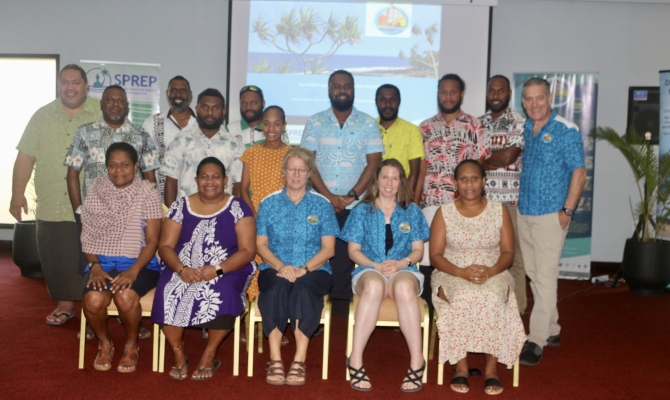
18 June 2024, Port Vila, Vanuatu — Vanuatu's ability to conduct climate hazard-based impact assessments has significantly improved following a comprehensive training workshop from 3-7 June 2024.
The workshop focused on practical training using a newly developed step-by-step guide for climate hazard-based impact assessments, tailored specifically for Vanuatu.
The guide was created by the Commonwealth Scientific and Industrial Research Organisation (CSIRO), a key Van-KIRAP delivery partner from Australia.
This represents a significant stride towards strengthening Vanuatu's preparedness and response to climate-related hazards, ensuring a more resilient future for the island nation.
"Physical climate hazards experienced by Vanuatu are already impacting the people, culture, economy and environment of the country in a material way” said Mr Geoff Gooley, Program Manager, Pacific Climate Science and Services, CSIRO.
“These hazards include sea level rise and coastal inundation, tropical cyclones, extreme temperatures and rainfall, flooding and drought, marine heatwaves and coral bleaching. The impacts of these hazards on sectors are expected to continue and in some cases increase due to climate change over the next several decades.
“It follows that a structured and systematic approach to assessment of hazard-based climate impacts is a key capability for Vanuatu sectors to provide science-based evidence to better inform policy development, adaptation planning and associated decision-making.”
The week-long event, co-hosted by the Vanuatu Meteorology and Geo-hazards Department (VMGD), the Secretariat of the Pacific Regional Environment Programme (SPREP), and the Vanuatu Klaemet Infomesen blong Redy, Adapt mo Protekt (Van-KIRAP), was funded by the Green Climate Fund (GCF).
Participants included representatives from various governmental sectors such as the Vanuatu Department of Agriculture & Rural Development, Vanuatu Public Works Department, Department of Climate Change, VMGD, National Disaster Management Office (NDMO), NDMO TAFEA Province, and the National Advisory Board on Climate Change and Disaster Risk Reduction (NAB) under the Ministry of Climate Change. They are now equipped with enhanced skills and knowledge that they can disseminate within their respective departments.
"The training on the guide and the Vanuatu Climate Futures Portal was good and very useful for sectoral planning for the future,” said Mr. Brian Iarapia, Climate Intern, VMGD. "As a young Vanuatu climate researcher, the guideline gives me the tools and knowledge to effectively contribute to climate resilience efforts and better understand how to integrate climate data into our national planning strategies."
“The final CSIRO mission was an important one for VMGD, particularly for the Climate Services Division. We were able to navigate through the Vanuatu Climate Futures Portal together with the CSIRO Experts knowing that the sustainability of the portal lies with the Climate Services team,” said Mr John Ruben, Principal Scientific Officer, Climate Services Division, VMGD.
“The workshop also allowed the team to learn how to conduct an economic cost benefit assessment which incorporates environment, economic and social aspects. Furthermore, the workshop provided the opportunity to contribute to the pre-planning of the VanKIRAP Phase II, making sure that the next phase of the project upscales and expands on the climate information services in Vanuatu.”
The newly introduced guide follows an eight-step process designed to help government sectors perform essential hazard-based risk assessments. These assessments are crucial for informing climate change actions and strategies aimed at building resilience across the nation.
For more details and to download a copy of the new guide, visit: https://library.sprep.org/sites/default/files/2023-09/Van-KIRAP-Climate-Assessment-Guidance.pdf